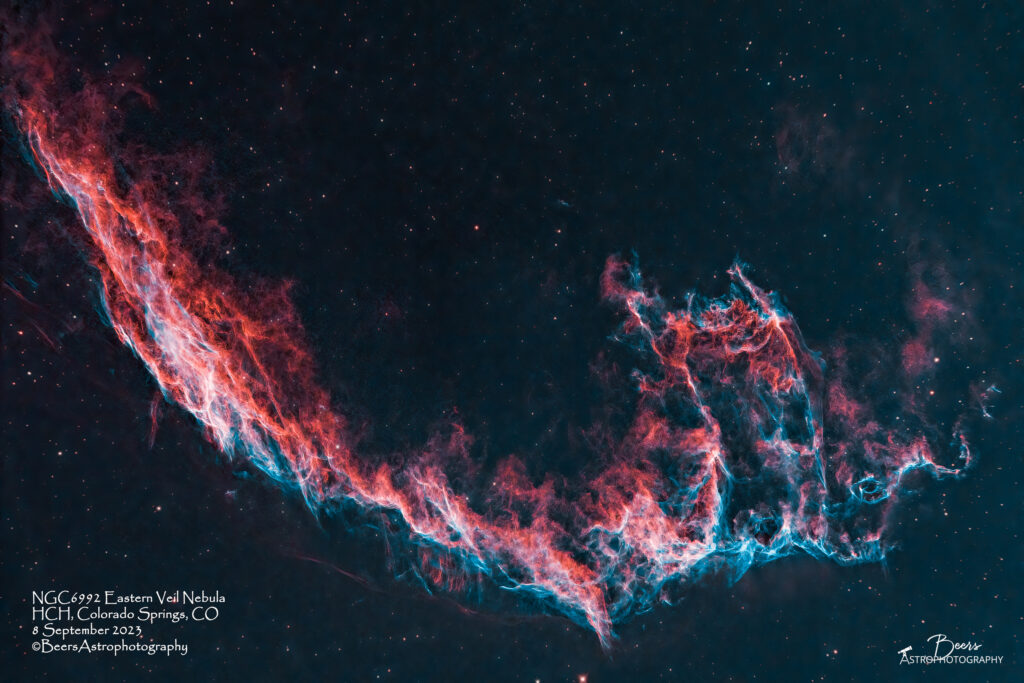
Fun facts
NGC6992 Eastern Veil (also known as Caldwell 33), whose brightest area is NGC 6992, trailing off farther south into NGC 6995 (together with NGC 6992 also known as “Network Nebula”) and IC 1340. It is one of the major portions of the Veil Nebula, that has acquired its own name and catalogue identifier.
The full Veil Nebula (shown in the gallery here: https://beersastrophotography.com/gallery/cygnus-loop-veil-nebula-ngc6960-western-veil-witchs-broom-ngc6992-eastern-veil-pickerings-triangle/ ) is a cloud of heated and ionized gas and dust in the constellation Cygnus. It constitutes the visible portions of the Cygnus Loop, a supernova remnant. The source supernova was a star 20 times more massive than the Sun which exploded between 10,000 and 20,000 years ago. At the time of explosion, the supernova would have appeared brighter than Venus in the sky, and visible in daytime. The remnants have since expanded to cover an area of the sky roughly 3 degrees in diameter (about 6 times the diameter, and 36 times the area, of the full Moon). While previous distance estimates have ranged from 1200 to 5800 light-years, a recent determination of 2400 light-years is based on direct astrometric measurements.
The Hubble Space Telescope captured several images of the nebula. The analysis of the emissions from the nebula indicates the presence of oxygen, sulfur, and hydrogen. The Cygnus Loop is also a strong emitter of radio waves and x-rays.
Other Catalog Designations: NGC 6992 Eastern Veil Nebula, 6995, IC 1340, C33, Ced 182b, Cygnus Loop, Network Nebula
Subtype: Supernova Remnant
Distance from Earth: 1470 light years
Visual Magnitude: 7.0
Apparent Size: 1º x 8′
Constellation: Cygnus
{From: https://en.wikipedia.org/wiki/Veil_Nebula }
Capture Notes:
After a week of clear nights and a waning moon (72% on Monday when I captured the Cave Nebula, 61.9% Tuesday, 51.6% Wednesday, 41.6% Thursday, to a late rising (0012MDT) 32.1% on Friday night) where I had promised Paul I would get some sleep to be rested for an important work meeting on Friday midday, I was chomping at the bit to take advantage of Friday’s clear night. Especially since the forecast for the next week, when we were planning our dark skies trip had turned south – rain storms and clouds everywhere – likely cancelling the trip.
I began the night imaging NGC6992 Eastern Veil Nebula, initially planning to image that all night. When I looked at the time it set – 0330MDT – and knowing it was a Saturday morning when I could image until the end of nautical twilight, I opted for IC59/IC63 as the second target for the night. I imaged Veil until approximately 0230MDT, when the Ghosts were past their meridian flip, and switched to them for the rest of the night.
Again, the autoguider is much more reliable on the west side of the meridian. I experienced an hour-long interruption of imaging starting at 2139MDT (theoretically because of a lost guide star), that I discovered when I went out to do that meridian flip at 2250MDT. The flip took several attempts while I was still within the 15 minute window of the meridian. Once I was about 15 minutes past the flip, it tracked and autoguided flawlessly for the rest of the night. (Additional note: after these autoguider stuggles for the last few months, it dawned on me that I had turned off the SGP automatic meridian flip option at about the time I started having issues). That function lets you set a time past the meridian to execute the flip. So, on Saturday morning – in preparation for imaging on Saturday night – I turned that function back on…although I wasn’t anywhere near the meridian with Saturday’s imaging, so not a real test of the “solution,” I didn’t have any autoguider issues.
There’s that lesson again: if it ain’t broke – don’t mess with the settings!
Equipment
Polar alignment: QHYCCD camera (controlled by Polemaster)
Imaging stream: (Big Bertha) Orion 8″ f/8 Ritchey-Chretien Astrograph Telescope, ZWO ASI2400MC#2 imaging camera, Optolong LeXtreme light pollution filter
Mount: SkyWatcher EQ6‑R PRO Synscan mount (controlled by ASCOM driver)
Autoguider: Orion 60mm Multi-Use Guide Scope, Orion StarShoot AutoGuider Pro Mono Astrophotography Camera (controlled by PHD2)
All equipment controlled by Windows 11 HP Probook (DSO-CTRL-2) running Sequence Generator Pro v4.2.
Capture & processing notes
Sequence plan: Gain: 158, Temp: -0°C, offset=30; 48x5min. Total exposure time: 4:00hrs. Captured 8Sep2023, 2048MDT – 9Sep2023, 0223MDT
Captured: 8 September 2023
Shooting location: HCH, Colorado Springs, Colorado
Processing: Captured in SGP, stacked in APP, star removal with Starnet++, processing with LR/PS
